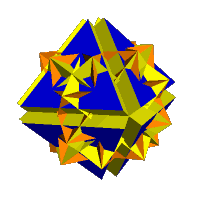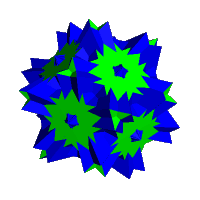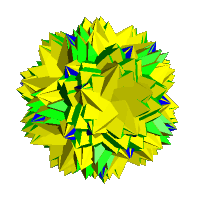Locally Convex Octahedral and Icosahedral
Polyhedra



Robert Webb,
the author of the Great Stella polyhedral program, contacted me regarding a search he had conducted for polyhedra, in
addition to the uniform polyhedra, which meet the following criteria:
(1) Regular faces.
(2) Locally-convex, i.e. none of the dihedral angles are reflex.
(3) All vertices are vertices of the model's convex hull.
(4) Octahedral or icosahedral symmetry.
I refer to polyhedra meeting these criteria as Type
I polyhedra.
I relaxed Robert's criterion (3) slightly to
allow further polyhedra
to be generated. Criterion (3) became:
(3) All vertices lie on the exterior of the polyhedron.
I refer to polyhedra meeting these criteria as Type
II polyhedra. A Type I polyhedron is automatically also a Type
II polyhedron. I am still finding additional examples, and
would be very surprised if the current list were to be complete.
It should be stressed that condition (4) is an
arbitrary limitation added only to confine the resulting list to manageable
proportions.
The uniform polyhedra themselves meet Type I
criteria. All further polyhedra discovered to date have been formed by augmenting
or excavating uniform polyhedra or augmented uniform polyhedra. The process of augmenting or excavating a polyhedron means to replace
one or more sides of the original polyhedron with a further polyhedron having
one side co-incident with a side of the original polyhedron. I define augmentation
as outward (away from the centroid of the vertex figure), excavation as inwards (towards the
centroid of the vertex figure). Note that this definition is slightly
different to that used by Great Stella.
For each of the uniform polyhedra, I have defined
a 'convexity'. This is normally considered to be; global (i.e. the
polyhedron is globally convex - the Platonic and Archimedean polyhedra fall into
this category), local (the polyhedron is locally convex - i.e. the polygons at
each vertex all cycle the vertex in the same direction) or non-convex
(the vertex is crossed). In the latter case I have distinguished
between non-convex vertices of the type m-n-m'-n' or m-n-m'-n (where m' is a
retrograde m) and other vertices having retrograde polygons. In
certain cases the latter can be augmented by excavating the retrograde polygon
with a suitable polyhedron and restoring the local convexity of the
vertex. (Care must be taken in the selection of the excavating polyhedron,
it must itself be locally convex, it must have the requisite pyramidical symmetry
(3-, 4- or 5-fold) and it must be sized such that the new vertices
are visible on the exterior of the resulting polyhedron.) I term the
convexity of these polyhedra 'potential'. Polyhedra with vertices of the
forms first referred to above I designate as having a convexity of 'none'.
Augmentation can be performed in one of five (or six) ways
(diagrams):
(a) one or more of the faces adjoining a locally convex vertex can be augmented, the limiting factor is to retain
the local convexity of the vertex.
(b) all of the faces adjoining a locally convex vertex can be
excavated. The
excavation must be deep enough to re-create a (highly wound) locally convex vertex (with
opposite polarity to the original).
(b') a variation on case (b)
where one of the original faces is left un-excavated. The remaining excavations are deep enough to re-create a (highly wound) locally convex vertex (with
opposite polarity to the original).
(c) one or more of the faces adjoining a locally convex vertex can be excavated,
the excavating polyhedron must have one (and only one) retrograde face.
This face is then the face used for excavation. The excavation must be
shallow enough to retain the local convexity of the vertex. Such an
excavation would normally add to the 'winding number' of the vertex figure.
(d) the retrograde face of certain polyhedra with crossed
vertices can also have its vertices uncrossed by excavating the retrograde
polygon with a suitable locally convex polyhedron. Again such an
excavation would normally add to the 'winding number' of the vertex figure.
(e) all of the prograde faces of
certain polyhedra with crossed
vertices can also have its vertices uncrossed by excavating the prograde
polygons with suitable locally convex polyhedra.
Combinations of the above are also
possible in a single augmentation, e.g.(ac), (cd) or (ad).
Second order augmentations and beyond can be generated by
augmenting one of the new faces added during an augmentation or an
excavation. Care must be taken that all vertices remain locally
convex.
In the table below, the description of the augmented forms is given
as 'Augment/Excavate {m},{n} with X,Y'. {m} and {n} are the faces of the original polyhedron, X
and Y are the additional polyhedra attached to {m} and {n} respectively. A short table of abbreviations is given below:
Pn : n-gonal prism
Qn: n-gonal cupola
Sn: n-gonal antiprism
Yn : n-gonal pyramid
Unn : Uniform polyhedron no. nn from the list below.
Jnn : Johnson Solid no. nn
GJnn : 'Great' Isomorph to Johnson Solid no. nn
RK'...' : Faceting
of Uniform Polyhedron (as discovered by Dr Richard Klitzing)
At times I also refer to individual augmentations
as 10a, 10b etc. 10a is simply the first listed
augmentation of polyhedron 10 (the octahedron). The form 10aa
would be the first listed augmented form of 10a. etc.
Clicking on the uniform polyhedron name links to a page describing the augmented forms in
detail. For the augmented forms, clicking on the description
links directly to a VRML model. Clicking on the number in the left column links to a VRML
model of the uniform polyhedron.
A gallery
of all discovered augmented forms is linked here.
| No |
Vertex |
Name |
Convexity
|
Augmented Forms |
| 01 |
n,4,4 |
Pentagonal
Prism |
Global |
|
| 02 |
n,3,3,3 |
Pentagonal
Anti-prism |
Global |
|
| 03 |
n/d,4,4 |
Pentagrammic
Prism |
Global |
|
| 04 |
n/d,3,3,3 |
Pentagrammic
Anti-Prism |
Global |
|
| 05 |
n/(n-d),3,3,3 |
Pentagrammic
Crossed Anti-Prism |
Potential |
|
| 06 |
3,3,3 |
Tetrahedron |
Global |
|
| 07 |
6,6,3 |
Truncated
Tetrahedron |
Global |
|
| 08 |
3,6,3/2,6 |
Octahemioctahedron |
None |
|
| 09 |
3,4,3/2,4 |
Tetrahemihexahedron |
None |
|
| 10 |
3,3,3,3 |
Octahedron |
Global |
Type
I(b): Excavate {3}
with P3 ("10a")
Type II(a): Augment {4} in 10a above with Y4
Type II(b): Excavate {3} with Y3 |
| 11 |
4,4,4 |
Cube |
Global |
Type
I(b): Excavate {4}
with S4
Type II(b): Excavate {4} with Y4 |
| 12 |
4,3,4,3 |
Cuboctahedron |
Global |
|
| 13 |
6,6,4 |
Truncated
Octahedron |
Global |
|
| 14 |
8,8,3 |
Truncated
Cube |
Global |
|
| 15 |
4,4,4,3 |
Rhombicuboctahedron |
Global |
|
| 16 |
8,6,4 |
Truncated
Cuboctahedron |
Global |
|
| 17 |
4,3,3,3,3 |
Snub
Cuboctahedron |
Global |
|
| 18 |
4,8,3/2,8 |
Small
Cubicuboctahedron |
Potential |
Type II(d): Excavate {3/2} with U17 |
| 19 |
4,8/3,3,8/3 |
Great
Cubicuboctahedron |
Local |
Type
I(a): Augment {4} with
Y4
Type II(b): Excavate {8/3},{4},{3} with S8/3,Y4,S3
Type II(c): Excavate {8/3} with Q8/5
|
| 20 |
4,6,4/3,6 |
Cubohemioctahedron |
None |
|
| 21 |
8/3,6,8 |
Cubitruncated
Cuboctahedron |
Local |
Type
II(a): Augment {8}
with Q4 |
| 22 |
4,4,3/2,4 |
Great
Rhombicuboctahedron |
Potential |
Type
I(d): Excavate
{3/2} with P3
Type II(a): Augment {3} in P3 in 22a above with Y3
Type II(d): Excavate {3/2} with S3
Type II(ad): Excavate {3/2}
with P3 & Augment {2nd & 3rd 4} with Y4
Type II(a): Augment {3}
in P3 in 22c above with Y3
Type II(ad): Excavate
{3/2}
with S3 & Augment {2nd & 3rd 4} with Y4 |
| 23 |
8,4,8/7,4/3 |
Small
Rhombicube |
None |
|
| 24 |
8/3,8/3,3 |
Stellatruncated
Cube |
Potential |
Type
I(b'): Excavate {8/3}
with Y8/3
Type II(b): Excavate {8/3},{3} with Y8/3,Y3
Type I(c): Excavate {8/3} with S8/5(Y8/3)
|
| 25 |
6,4,8/3 |
Great
Truncated
Cuboctahedron |
Local |
Type
I(a):
Augment {6}
with S6 |
| 26 |
8/3,4,8/5,4/3 |
Great
Rhombicube |
None |
|
| 27 |
3,3,3,3,3 |
Icosahedron |
Global |
Type
I(b): Excavate {3} with Q3
Type II(a): Augment {6} in Q3 in 27a above with ortho-Q3
Type II(b): Excavate {3} with Y3 |
| 28 |
5,5,5 |
Dodecahedron |
Global |
Note |
| 29 |
5,3,5,3 |
Icosidodecahedron |
Global |
|
| 30 |
6,6,5 |
Truncated
Icosahedron |
Global |
|
| 31 |
10,10,3 |
Truncated
Dodecahedron |
Global |
|
| 32 |
5,4,3,4 |
Rhombicosidodecahedron
(small) |
Global |
|
| 33 |
10,6,4 |
Truncated
Icosidodecahedron |
Global |
|
| 34 |
5,3,3,3,3 |
Snub
Icosidodecahedron |
Global |
|
| 35 |
3,5/2,3,5/2,3,5/2 |
Small
Ditrigonal Icosidodecahedron |
Local |
Type
II(b): Excavate {5/2},(3)
with P5/2,P3 |
| 36 |
3,6,5/2,6 |
Small
Icosicosidodecahedron |
Local |
|
| 37 |
5/2,3,3,3,3,3 |
Snub
Disicosidodecahedron |
Local |
|
| 38 |
5,10,3/2,10 |
Small
Dodecicosidodecahedron |
Potential |
|
| 39 |
5/2,5/2,5/2,5/2,5/2 |
Small
Stellated Dodecahedron |
Local |
Type
II(b): Excavate {5/2}
with S5/2
Type II(c): Excavate {5/2} in S5/2 above with Q5/3
Type II(b): Excavate {5/2} with U59
Type II(b): Excavate {5/2} with U79
Type II(c): Excavate {5/2} with GJ06 |
| 40 |
(5,5,5,5,5)/2 |
Great
Dodecahedron |
Local |
Type
I(b): Excavate {5}
with P5 |
| 41 |
5/2,5,5/2,5 |
Dodecadodecahedron |
Local |
Type
I(a): Augment {5} with
Y5 |
| 42 |
10,10,5/2 |
Great
Truncated Dodecahedron |
Local |
|
| 43 |
5,4,5/2,4 |
Rhombidodecadodecahedron |
Local |
|
| 44 |
4,10,4/3,10/9 |
Small
Rhombidodecahedron |
None |
|
| 45 |
5/2,3,5,3,3 |
Snub
Dodecadodecahedron |
Local |
Type
I(a): Augment {5} with
Y5 |
| 46 |
5/3,5,5/3,5,5/3,5 |
Ditrigonary
Dodecadodecahedron |
Potential |
Type
II(d): Excavate {5/3}
with P5/2
Type II(c): Excavate {5/2} in P5/2 in 46a above with Q5/3
Type II(a): Augment {4} in Q5/3 in 46aa above with Y4 |
| 47 |
5,10/3,3,10/3 |
Great
Dodekified Icosidodecahedron |
Local |
Type
I(a): Augment {5} with
Y5 |
| 48 |
3,10,5/3,10 |
Small
Dodekified Icosidodecahedron |
Potential |
|
| 49 |
5,6,5/3,6 |
Icosified
Dodecadodecahedron |
Potential |
|
| 50 |
10,6,10/3 |
Icositruncated
Dodecadodecahedron |
Local |
Type
II(a): Augment {10}
with Q5 |
| 51 |
5/3,3,5,3,3,3 |
Snub
Icosidodecadodecahedron |
Potential |
|
| 52 |
(5,3,5,3,5,3)/2 |
Great
Ditrigonary Icosidodecahedron |
Local |
Type
II(a): Augment {5}
with Y5 |
| 53 |
5,6,3/2,6 |
Great
Icosified Icosidodecahedron |
Potential |
Type
II(d): Excavate {3/2} with U07 |
| 54 |
3,10,3/2,10 |
Small
Icosihemidodecahedron |
None |
|
| 55 |
6,10,6/5,10/9 |
Small
Dodekicosahedron |
None |
|
| 56 |
5,10,5/4,10 |
Small
Dodecahemidodecahedron |
None |
|
| 57 |
5/2,5/2,5/2 |
Great
Stellated Dodecahedron |
Local |
Type
II(b): Excavate {5/2}
with Y5/2
Type II(b): Excavate {5/2} with P5/2 |
| 58 |
(3,3,3,3,3)/2 |
Great
Icosahedron |
Local |
Type
I(b): Excavate {3}
with Y3 |
| 59 |
5/2,3,5/2,3 |
Great
Icosidodecahedron |
Local |
Type
II(a): Augment {3}
with Y3
Type I(b): Excavate {5/2},{3} with Y5/2,Y3
Type II(b): Excavate {5/2},{3} with S5/2,Y3
Type II(c): Excavate {5/2} with S5/3(Y5/2)
|
| 60 |
6,6,5/2 |
Great
Truncated Icosahedron |
Local |
|
| 61 |
6,4,6/5,4/3 |
Rhombicosahedron |
None |
|
| 62 |
5/2,3,3,3,3 |
Great
Snub Icosidodecahedron |
Local |
|
| 63 |
10/3,10/3,5 |
Small
Stellatruncated Dodecahedron |
Local |
|
| 64 |
10,10/3,4 |
Stellatruncated
Dodecadodecahedron |
Local |
Type
I(a):
Augment {10}
with S10 |
| 65 |
5/3,3,5,3,3 |
Vertisnub
Dodecadodecahedron |
Potential |
Type I(d): Excavate {5/3}
with U35
Type I(d): Excavate {5/3} with RK'sid-6-10-0-2' |
| 66 |
10/3,5/2,10/3,3 |
Great
Dodekicosidodecahedron |
Local |
Type
II(a): Augment {3}
with Y3
Type II(b): Excavate {10/3},{5/2},{3} with S10/3,P5/2,P3
Type II(c): Excavate {5/2} in P5/2 in 66b above with
Q5/3 |
| 67 |
5/2,6,5/3,6 |
Small
Dodecahemicosahedron |
None |
|
| 68 |
10/3,6,10/7,6/5 |
Great
Dodekicosahedron |
None |
|
| 69 |
5/3,3,5/2,3,3,3 |
Great
Snub Icosidisdodecahedron |
Potential |
Type
II(d): Excavate {5/3}
with P5/2
Type II(a): Augment {4} in P5/2 in 69a above with Y4
Type II(c): Excavate {5/2} in P5/2 in 69a above with Q5/3
Type II(e): Excavate {5/3} with S5/2
Type II(cd): Excavate {5/3},{5/2} with P5/2,Q5/3
Type II(c): Excavate {5/2} in P5/2 in 69c above with Q5/3
Type II(a): Augment {4} in Q5/3
in 69c above with Y4
Type II(ac): Augment {4} in
Q5/3, excavate {5/2} in P5/2 in in 69c above with Y4,Q5/3
Type II(cd): Excavate {5/3},{5/2} with S5/2,Q5/3
|
| 70 |
6,5,6,5/4 |
Great
Dodecahemicosahedron |
None |
|
| 71 |
3,10/3,10/3 |
Great
Stellatruncated Dodecahedron |
Local |
Type
II(a): Augment {3}
with Y3
Type II(b): Excavate {10/3},{3} with Y10/3,S3
Type II(b): Excavate {10/3},{3} with Q5/3(P5/2),S3 |
| 72 |
4,5/3,4,3 |
Great
Rhombicosidodecahedron |
Potential |
Type
I(d): Excavate {5/3}
with P5/2
Type II(a): Augment {5/2} in P5/2 in 72a above with Y5/2
Type II(d): Excavate {5/3} with S5/2
Type II(e): Excavate {4},{3} with Y4,S3
Type II(ad): Excavate {5/3}
with P5/2 & Augment {4} with Y4
Type II(a): Augment {5/2} in P5/2 in 72d above with Y5/2 |
| 73 |
6,10/3,4 |
Stellatruncated
Icosidodecahedron |
Local |
|
| 74 |
5/3,3,3,3,3 |
Great
Vertisnub Icosidodecahedron |
Potential |
Type
I(d): Excavate {5/3}
with S5/2
Type II(d): Excavate {5/3} with U59
Type II(d): Excavate {5/3} with GJ06
Type II(a): Augment {10/3} in GJ06 in 74c above with Y10/3 |
| 75 |
5/2,10/3,5/3,10/3 |
Great
Dodecahemidodecahedron |
None |
|
| 76 |
3,10/3,3/2,10/3 |
Great
Icosihemidodecahedron |
None |
|
| 77 |
(5/3,3,3,3,3,3)/2 |
Small
Retrosnub Icosicosidodecahedron |
Potential |
Type
I(d): Excavate {5/3}
with Y5/2
Type II(e): Excavate {3} with Y3
Type II(d): Excavate {5/3} with U79
Type II(da): Excavate {5/3},augment 2nd {3} with Y5/2,Y3
Type II(da): Excavate {5/3},augment 2nd&3rd {3} wuth
Y5/2,Y3 |
| 78 |
10/3,4,10/7,4/3 |
Great
Rhombidodecahedron |
None |
|
| 79 |
(5/2,3,3,3,3)/2 |
Great
Retrosnub Icosidodecahedron |
Local |
Type
II(a): Augment 2nd {3}
with Y3
Type II(a): Augment {5/2} with Y5/2
Type II(b): Excavate {5/2},{3} with Y5/2,U24
Type II(c): Excavate {5/2} with modified 77a
Type I(c): Excavate {5/2} with S5/3(Y5/2)
Type II(ca): Excavate {5/2},augment 2nd{3} with S5/3(Y5/2),Y3
Type II(c): Excavate {5/2} with S5/3(S5/2)
Type II(ca): Excavate {5/2},augment 2nd{3} with
S5/3(S5/2),Y3
|
| 80 |
(5/2,4,3,4,
5/3,4,3/2,4)/2 |
Great
Disnub Disicosidisdodecahedron |
Potential |
|
Credits and Great Stella Files
All of the augmented polyhedra were generated
using Robert Webb's Great Stella
program, except for the occasional framework models which were generated using Hedron.
Thanks to Robert for introducing the idea for this search and for providing the
initial examples 19a, 41a, 45a
and 47a.
For users of Great Stella: Stella files of
all the augmented polyhedra are included in these archives: augment1.zip
(octahedral: polyhedra 1-26), augment2.zip
(icosahedral part 1: polyhedra 27-59), augment3.zip
(icosahedral part 2: polyhedra 60-71), augment4.zip
(icosahedral part 3: polyhedra 72-80).
Updates
27-Jan-03: Set of VRML files completed.
3-Dec-02: 24c, 59d,
77d,77e, 79e,79f,79g,79h
25-Nov-02: 19c, 39aa,
46aa,46aaa, 66ba, 69cb,69cc,
71c, 79d
7-Nov-02: 27a,27aa, 28a,
39d, 53a, 64a,
65b, 74c,74ca, 79c


